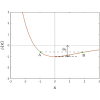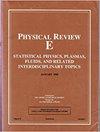莫尔斯势中波包的量子动力学:动力系统方法
IF 2.4
3区 物理与天体物理
Q1 Mathematics
引用次数: 0
摘要
我们展示了动力学系统方法如何出人意料地与莫尔斯势中振荡和逃逸的量子动力学相关。我们将该方法得出的动力学结果与相关薛定谔方程的直接数值积分结果进行了比较,以支持我们的说法。数值研究的一个有趣发现是,在超过波包临界能量的经典禁止范围内,获得相当一部分(超过 50%)波包的概率明显增加。动力学系统方法在临界能量附近显示出不稳定性,这一事实明确表明了动力学系统与量子动力学的相关性。在较低能量下,从动力学系统计算出的平均位置〈x〉和方差 V 可以让我们清楚地确定隧穿现象,因为在不同时间,总和〈x〉+ V 明显超过了相应能量下位移的经典约束。本文章由计算机程序翻译,如有差异,请以英文原文为准。

Quantum dynamics of wave packets in a Morse potential: A dynamical system approach
We show how a dynamical systems approach can, somewhat unexpectedly, be relevant in the quantum dynamics featuring oscillations and escape in the Morse potential. We compare the dynamics resulting from the approach with the results obtained from a direct numerical integration of the relevant Schrödinger equation to support our claim. An interesting finding of the numerical investigation is the marked increase in the probability of obtaining a significant fraction (more than ) of the wave packet in the classically forbidden range beyond a critical energy of the packet. The fact that the dynamical systems approach shows an instability near that critical energy is a definite indication of the relevance of dynamical systems to the quantum dynamics. At lower energies, the calculated mean position and variance from the dynamical system allow us to clearly establish the phenomenon of tunneling since the sum clearly exceeds, at various times, the classical bound on displacement for the corresponding energy.
求助全文
通过发布文献求助,成功后即可免费获取论文全文。
去求助
来源期刊

Physical review. E
物理-物理:流体与等离子体
CiteScore
4.60
自引率
16.70%
发文量
0
审稿时长
3.3 months
期刊介绍:
Physical Review E (PRE), broad and interdisciplinary in scope, focuses on collective phenomena of many-body systems, with statistical physics and nonlinear dynamics as the central themes of the journal. Physical Review E publishes recent developments in biological and soft matter physics including granular materials, colloids, complex fluids, liquid crystals, and polymers. The journal covers fluid dynamics and plasma physics and includes sections on computational and interdisciplinary physics, for example, complex networks.
 求助内容:
求助内容: 应助结果提醒方式:
应助结果提醒方式:


